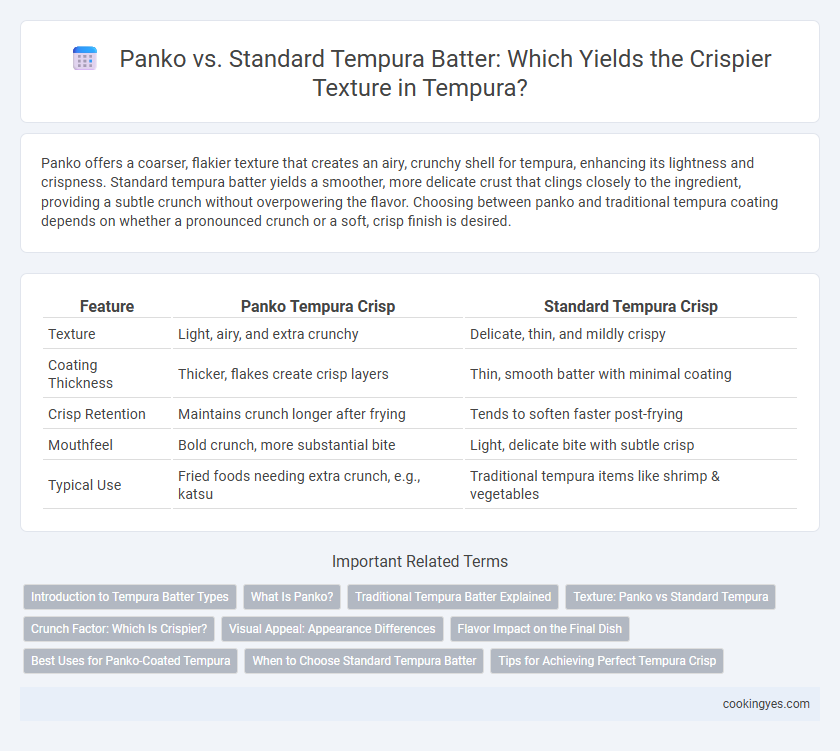Panko offers a coarser, flakier texture that creates an airy, crunchy shell for tempura, enhancing its lightness and crispness. Standard tempura batter yields a smoother, more delicate crust that clings closely to the ingredient, providing a subtle crunch without overpowering the flavor. Choosing between panko and traditional tempura coating depends on whether a pronounced crunch or a soft, crisp finish is desired.
Table of Comparison
| Feature | Panko Tempura Crisp | Standard Tempura Crisp |
|---|---|---|
| Texture | Light, airy, and extra crunchy | Delicate, thin, and mildly crispy |
| Coating Thickness | Thicker, flakes create crisp layers | Thin, smooth batter with minimal coating |
| Crisp Retention | Maintains crunch longer after frying | Tends to soften faster post-frying |
| Mouthfeel | Bold crunch, more substantial bite | Light, delicate bite with subtle crisp |
| Typical Use | Fried foods needing extra crunch, e.g., katsu | Traditional tempura items like shrimp & vegetables |
Introduction to Tempura Batter Types
Tempura batter varies primarily between panko and standard tempura crisp, influencing texture and mouthfeel. Panko tempura batter incorporates light, flaky Japanese breadcrumbs, creating an airier, crunchier coating compared to the traditional smooth, thin tempura batter made from cold water, flour, and egg. Understanding these differences helps chefs and enthusiasts achieve the desired crispness and lightness in tempura dishes.
What Is Panko?
Panko is a Japanese-style breadcrumb made from crustless white bread, known for its airy, flaky texture that creates an exceptionally light and crunchy coating compared to standard tempura batter. Unlike traditional tempura crisp, which relies on a wet batter of flour, egg, and cold water for a delicate and thin crust, panko adds a coarser, more textured crunch that retains crispness longer. This unique structure of panko enhances the mouthfeel and provides a satisfying crispier bite, making it ideal for tempura variations seeking extra crunch.
Traditional Tempura Batter Explained
Traditional tempura batter relies on a delicate balance of ice-cold water, flour, and sometimes egg to create a light, airy, and crisp texture that panko cannot replicate due to its coarser crumb structure. Panko breadcrumbs, made from crustless white bread, produce a crunchier, heavier coating suited for fried dishes but diverge from the ethereal crispness central to authentic tempura. Standard tempura crisp results from minimal gluten development and rapid frying, yielding a thin, brittle crust that highlights the freshness of ingredients, distinguishing it from the thicker, more robust texture of panko coatings.
Texture: Panko vs Standard Tempura
Panko offers a coarser, flakier texture that creates a crunchier and airier bite compared to standard tempura batter, which tends to be lighter and more delicate with a subtle crispness. Standard tempura batter uses cold water and a thin flour mixture that results in a smooth, crispy coating that emphasizes a gentle crunch rather than robust crispiness. The choice between panko and traditional tempura batter significantly impacts the mouthfeel, with panko delivering a more pronounced crunch and tempura providing a lighter, melt-in-the-mouth texture.
Crunch Factor: Which Is Crispier?
Panko breadcrumbs create a coarser, airier texture that enhances the crunch factor in tempura, making it distinctly crispier than the traditional tempura batter. Standard tempura batter, made from cold water and flour, yields a lighter, more delicate crisp but lacks the intense crunchiness provided by panko. For those seeking maximum crunch, panko tempura coating offers a superior tactile experience that holds up well even after frying.
Visual Appeal: Appearance Differences
Panko tempura offers a coarser, flakier texture that creates a visibly lighter and airier crust compared to the smoother, more uniform coating of standard tempura batter. The irregular, golden flakes of panko produce a rustic, crunchy exterior that enhances the visual appeal by highlighting contrast and depth on fried items. Standard tempura's fine, delicate batter results in a consistent, glossy finish that emphasizes elegance and subtle crispness without overwhelming the ingredient's natural shape.
Flavor Impact on the Final Dish
Panko tempura batter creates a lighter, crunchier texture that enhances the natural flavors of the ingredients without overwhelming them. Standard tempura batter yields a slightly denser crust, providing a subtle, savory richness that complements the dish's umami notes. The choice between panko and standard tempura crisp directly influences the flavor profile and mouthfeel, tailoring the final dish to either a delicate or robust sensory experience.
Best Uses for Panko-Coated Tempura
Panko-coated tempura offers a lighter, crunchier texture compared to standard tempura batter, making it ideal for dishes that benefit from an extra crisp bite, such as shrimp or vegetable tempura. Its unique flaky texture enhances the contrast between the tender interior and the crispy exterior, elevating the overall eating experience. Panko tempura is best used for fried items that require a more substantial crunch without sacrificing lightness.
When to Choose Standard Tempura Batter
Standard tempura batter creates a light, airy, and delicate crisp texture ideal for ingredients that cook quickly, such as shrimp and thin vegetables. It is best chosen when maintaining the natural flavor and moisture of the ingredients is a priority, as it forms a thin, even coating that doesn't overpower the food. This batter excels in dishes where a subtle crunch complements the tender interior without adding extra weight or heaviness.
Tips for Achieving Perfect Tempura Crisp
For achieving the perfect tempura crisp, using panko breadcrumbs can enhance texture by providing a coarser, airier crunch compared to standard tempura batter alone. Lightly dust ingredients with dry flour before dipping into a cold, well-mixed tempura batter made from ice-cold water and soft wheat flour to prevent sogginess. Fry at consistent high temperatures (around 350degF or 175degC) in small batches to ensure even cooking and maintain optimal crispness.
Panko vs Standard Tempura Crisp for Texture Infographic

 cookingyes.com
cookingyes.com